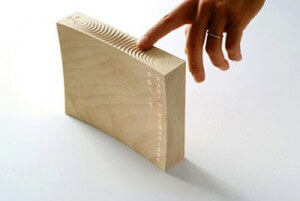
Do you dream of tangible interfaces?
Touch interfaces are becoming more and more popular. The iPhone and its younger brother, the iPod Touch, are highly responsible for this recent popularization. We will sure see more of this kind of products in our everyday lives. But are we restricted to gadgets with Plexiglas screens?
The answer is no. Popularization of tangible interfaces might be the next step in the evolution of interaction paradigms. With tangible interfaces we will be able to put aside the displays, in the way we use them today, to really own the products.
Let me introduce you to two products which are quite interesting and show the transition from gadgets to everyday products.
The White Fruit Radio from Swann Bourotte abandons the high-tech look. It’s a wood block with ridges on top. No speakers, no buttons and no visible LCD screens. The inside, on the other hand, is very different. Volume and tuning are controlled by touching the ridges on top. Stations are displayed under the wood layer. The sycamore used on the radio allows the LEDs on the inside to be seen and also guarantees and excellent sound quality.
The choice of material was the key of the product design. The use of wood changes the sense of touch, when compared to the use of plastic. Also, it has a link to actual music instruments. The ridges, for example, remind of a blues wash-board. Furthermore, the “empty space” (where probably lies the speaker) also gives margin for all sorts of customization: from attaching a picture to engraving your name on it. Essentially, it’s a simple product, but it allows people to bring their own individual references to it which, in the end, enrich the use experience.
Cushion control is a set of remotes created by the designers Didier Hilhorst and Nicholas Zambetti that completely avoids the “button bar” model. At first sight, it seems pretty obvious: cushions instead of the good old remote. But the interaction goes beyond that. What happens if we use them as pillows? Or, if we follow the scenario in the picture, we lay down to watch TV and we put the cushions under our feet? There is no need for fine motor control for any of the five available operations; we could easily control them with our feet.
From a social point of view, interaction models also change. It is possible to distribute tasks, but what will be the impact on “power relations”? Imagine a family with two children. Parents allow the kids to alternate channel controls and volume controls at each day. The kids watch TV until one of the parents brings the power on/off cushion. Bedtime would be directly associated with the presence of the object.
These two products are very close to becoming everyday products. They still have a “gadget soul”, a kind of technological nature, but it is easy to imagine their evolution into “transparent” interfaces.
As interfaces become “transparent”, the use experience becomes more important than the perception of the products. This “transparency” is an excellent measure of usability, since it is usability problems that interrupt the use experience taking our focus from our goals and putting it on the interface.
The dimension which stands out in both these products is the emotional dimension: the sentimental relations that can be easily created or remembered from using them. The purpose of these objects is not to make life more practical or more productive, but to make it more pleasant and more interesting. They reach this purpose in two ways: simplifying the product (less features, less buttons and less stress) and making it more fun (more imagination and more experimentation).
Should we consider these two dimensions (practical and emotional) as opposed or is it possible to design interfaces that consider both equally? Which one is more important to people’s satisfaction?
Tell me what you think, leave a comment!

0 Comment(s)